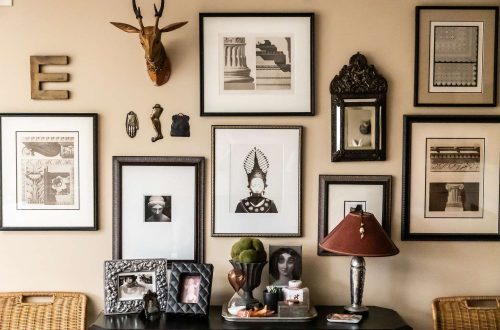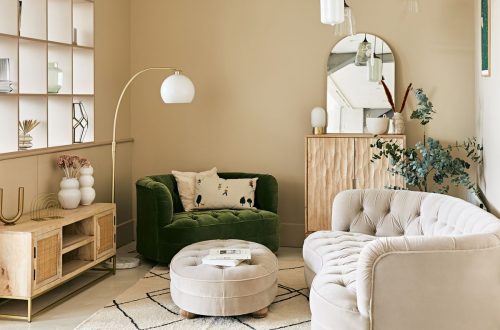The trend of incorporating natural textures into home decor is more than just a passing fad – it’s a movement toward creating spaces that feel calming, grounded, and connected to the natural world. In our increasingly digital and manufactured environment, there’s a profound human need to surround ourselves with authentic materials that speak to our senses. Natural textures do more than just add visual interest to a room; they create depth, warmth, and character that synthetic materials often can’t replicate. This comprehensive guide will explore how to effectively incorporate natural textures into your decor, creating spaces that feel both stylish and serenely connected to the natural world. From the warm earthiness of jute to the airy lightness of linen, natural textures offer endless possibilities for creating beautiful, tactile environments.
Texture 1: Jute and Sisal for Grounding
Jute and sisal are the workhorses of natural fiber flooring, offering durability and an earthy aesthetic that grounds a room in natural elements. Both materials provide a beautiful foundation for your space while adding an organic, tactile quality that synthetic materials simply can’t match.
Characteristics and Benefits:
Jute: Known for its soft, silky texture and natural golden color, jute is more supple underfoot than sisal. It has natural insulating properties and provides a softer feel underfoot, making it more comfortable for areas where you spend time sitting or lying down.
Sisal: More durable and resilient than jute, sisal has a coarser texture and is better suited for high-traffic areas. It’s naturally stain-resistant and maintains its appearance longer in heavily used spaces.
Installation Tip: Both jute and sisal work beautifully as area rugs or wall-to-wall installations. For high-traffic areas, choose sisal; for more intimate spaces where comfort is prioritized, jute is ideal.
Styling Jute and Sisal:
These natural fibers work exceptionally well in neutral or earth-toned color schemes, but don’t shy away from using them as a base for pops of color. The texture provides enough visual interest that you don’t need to worry about the color of the fiber appearing bland.
Pair jute and sisal with other natural elements like wood furniture and plants to create a cohesive natural aesthetic. The fibers’ natural color variations add visual texture that works well with both modern and traditional design styles.
Maintenance Note: Jute and sisal require regular vacuuming to prevent dirt from settling in the fibers. Address spills immediately, and avoid harsh chemicals that might damage the natural fibers.
Texture 2: Rattan and Wicker for a Light, Airy Feel
Rattan and wicker bring a distinctive, vacation-ready atmosphere to any room, adding a light, airy feel that’s perfect for creating a relaxed, bohemian, or coastal aesthetic. These materials are incredibly versatile and can work in both casual and sophisticated settings.
Understanding the Difference:
While often used interchangeably, rattan refers to the solid stem of a climbing palm, while wicker refers to the weaving technique that can use rattan, willow, or other materials. Rattan furniture tends to be more durable and substantial, while wicker pieces can be more intricate and decorative.
Best Applications for Rattan and Wicker:
- Accent Chairs: A rattan chair with a comfortable cushion creates an instant focal point while maintaining an airy feel.
- Lighting Pendants: Rattan light shades create beautiful, diffused lighting that adds texture to the ceiling plane.
- Decorative Baskets: These provide storage while contributing to the textural narrative of the room.
- Room Dividers: Larger rattan pieces can create functional separation without blocking light.
Care Consideration: While rattan and wicker are durable, they’re not suitable for high-moisture areas like bathrooms or outdoor spaces that are not covered. Excessive moisture can cause these materials to split or deteriorate.
Texture 3: Linen and Raw Cotton for Softness
Linen and raw cotton bring a wonderful, relaxed softness to a room that’s both tactile and visually appealing. These materials have a lived-in quality that adds authenticity and comfort to any space, making them perfect for creating environments where relaxation is paramount.
The Appeal of Natural Fibers:
Linen, made from flax fibers, has a distinctive texture that becomes softer and more beautiful with age. It has a natural tendency to wrinkle, which gives it an organic, relaxed appearance that’s increasingly prized in contemporary interiors.
Raw cotton, with its unfinished, natural look, adds a touch of rustic charm while maintaining a sophisticated appearance. Both materials are breathable and have natural temperature-regulating properties.
Color Strategy: Both linen and raw cotton look beautiful in their natural, unbleached states, but they also accept dyes well. Stick to natural, muted colors like soft blues, warm grays, or subtle greens to maintain the organic aesthetic.
Implementing Linen and Cotton:
Incorporate these textiles through curtains, throw pillows, table runners, and upholstered furniture. Linen curtains are particularly effective as they allow soft, filtered light while maintaining privacy.
Layer different weights of these fabrics for added visual interest – perhaps a heavy linen curtain paired with lighter cotton throw pillows, or raw cotton placemats with a linen table runner.
Texture 4: Clay and Terracotta for Warmth
Clay and terracotta elements provide an artisanal, warm touch that connects your space to ancient traditions of handmade pottery and ceramics. These materials add a rustic, authentic feel that’s both grounding and visually interesting.
Best Uses for Clay and Terracotta:
- Vases and Planters: Unglazed terracotta pots not only serve as planters but also enhance the natural look of the plants they contain.
- Decorative Bowls: These can be used for serving or as sculptural elements when not in use.
- Serving Dishes: Earthenware adds authenticity to table settings, especially for rustic or Mediterranean-inspired meals.
- Wall Art: Ceramic tiles or clay sculptures can add textural interest as wall decorations.
Color and Finish Considerations:
Traditional terracotta has a distinctive orange-brown color, but clay can be found in various hues depending on the region and firing techniques used. Raw, unglazed pieces showcase the natural texture and porosity of the clay, while lightly glazed options can add subtle sheen without losing the organic feel.
Artisanal Appeal: Embrace the imperfections in handmade clay and terracotta pieces. Slight variations in color, size, and texture are signs of authenticity and add to the organic, artisanal appeal.
How to Mix and Layer Natural Textures
The key to successfully incorporating natural textures without creating a chaotic or overwhelming space lies in the careful mixing and layering of different elements. The goal is to create a cohesive, harmonious environment that feels rich and varied without being cluttered.
The Thread Technique: Ensure a common color thread ties different textures together. This could be a specific hue that appears in your jute rug, linen curtains, and terracotta pottery, creating visual cohesion across different materials.
Layering Strategies:
Start with a foundation of larger textural elements like a jute or sisal rug, then add medium-scale elements such as a rattan chair or linen curtains. Finish with smaller accents like clay pottery, cotton throw pillows, and wooden accessories.
Balance rough textures with smooth ones. If you have a lot of coarse textures like raw jute, balance them with smoother elements like silk curtains or a glass table. This creates visual rest points within the textural narrative.
Proportion and Distribution:
Don’t cluster all your natural textures in one area of the room. Distribute them throughout the space to create visual balance. If you have a large rattan chair in one corner, perhaps add some clay pottery or wooden accessories to the opposite side of the room.
Consider the scale of different textures. A large, chunky wooden coffee table can be balanced with finer textures like delicate linen draping or small ceramic pieces.
Seasonal Adaptation of Natural Textures
One of the advantages of natural textures is their ability to adapt to seasonal changes, allowing you to refresh your space without replacing major elements. Understanding how to seasonally adjust your natural texture palette will keep your space feeling fresh and appropriate throughout the year.
Summer Adaptations:
In warmer months, emphasize lighter, more breathable textures. Switch to lighter weight linen curtains, add jute or seagrass accessories, and incorporate more ceramic pieces that feel cool and refreshing. Lighter colored cotton throws and pillows can maintain the natural texture feel while keeping the room feeling light.
Avoid heavy textures like thick wool or heavily textured items that might make the space feel too warm. Instead, opt for the airy quality of wicker and the cool feel of clay.
Winter Adaptations:
During colder months, layer in warmer textures like chunky hand-knit wool throws, heavier cotton blankets, and wooden elements with deeper, richer stains. The natural warmth of wood becomes especially important in winter, providing visual and tactile comfort.
Incorporate natural textures in deeper, warmer tones – think rust-colored terracotta, deep brown wooden elements, and rich, earth-toned linens.
Spring and Fall Transitions:
These transitional seasons offer opportunities to experiment with different combinations of textures. Spring might call for fresh cottons and lighter woods, while fall could embrace the harvest colors of terracotta and the rich textures of wool and heavier linens.
Maintaining Natural Textures
Proper care and maintenance ensure that your investment in natural textures continues to look beautiful and function well over time. Natural materials often require different care approaches than manufactured alternatives.
Caring for Natural Fiber Textiles:
Vacuum jute and sisal regularly with a brush attachment to prevent dirt from settling deep in the fibers. Address spills immediately by blotting (not rubbing) with a clean, damp cloth. For deeper cleaning, professional cleaning may be necessary to avoid damaging the natural fibers.
Linen and cotton items should be washed according to their care instructions, often with mild detergents and cool water to prevent shrinkage or damage. Air-drying helps maintain the natural characteristics of these fibers.
Sunlight Protection: Many natural textures, especially textiles, can fade when exposed to direct sunlight for extended periods. Use window treatments to filter harsh light while preserving the view and natural light in your space.
Maintaining Natural Materials:
Rattan and wicker should be dusted regularly with a soft brush attachment. If they become soiled, clean them with a damp cloth and mild soap, being careful not to saturate the material.
Wooden elements should be periodically cleaned with appropriate wood cleaners and may benefit from occasional conditioning to maintain their appearance and prevent drying or cracking.
Troubleshooting Common Texture Issues
Even with the best intentions, you might encounter challenges when incorporating natural textures into your decor. Understanding how to address these issues will ensure your efforts result in a beautiful, cohesive space.
Problem: Space Feels Too Rustic or “Dorm Room” Simple
Solution: Balance natural textures with more refined elements. Add metallic accents, a sleek lamp, or sophisticated artwork to elevate the look. The goal is to create a curated feel rather than a collected-over-time appearance.
Problem: Different Textures Seem to Compete Rather Than Complement
Solution: Establish a hierarchy of textures. Choose one or two dominant textures and use others as accents. Also, ensure that all textures share some common color or finish element to create visual unity.
Over-Texture Warning: Too many competing textures can make a space feel chaotic. If your room feels busy or overwhelming, consider removing or toning down some of your textural elements.
Problem: Natural Textures Don’t Match Existing Decor
Solution: Use a unifying element like color, finish, or style to bridge gaps. For example, if your existing decor is more modern, choose natural textures with clean lines and simple forms rather than ornate, heavily textured pieces.
Conclusion
Incorporating natural textures into your decor is one of the easiest and most effective ways to add depth, warmth, and character to any space. The combination of jute, sisal, rattan, linen, and clay elements creates an environment that feels grounded, authentic, and connected to the natural world.
The key to success lies in thoughtful layering and mixing of different textures, ensuring they’re balanced and cohesive rather than chaotic. Consider your room’s existing elements, the function of the space, and your personal preferences when selecting which natural textures to incorporate.
Remember that natural textures offer both visual and tactile benefits – they’re not just beautiful to look at but also provide a sensory experience that enhances your connection to your living space. The investment in natural textures pays dividends in the form of a home that feels both stylish and serenely connected to the natural world.
Start small if you’re new to incorporating natural textures, then gradually build to create a rich, layered, and inviting environment that reflects your appreciation for natural beauty and craftsmanship.





